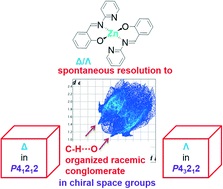Spontaneous resolution of a Δ/Λ-chiral-at-metal pseudo-tetrahedral Schiff-base zinc complex to a racemic conglomerate with C–H⋯O organized 41- and 43-helices†
Abstract
The Schiff-base ligand N-2-(pyridyl)salicylaldimine (HL) reacts with zinc(II) acetate or nitrate to obtain the enantiomorphous chiral-at-metal compound Δ/Λ-bis[N-2-(pyridyl)salicylaldiminato-κ2N,O]zinc(II), [Zn(L)2] (1), which crystallizes as a racemic conglomerate via spontaneous resolution. Two deprotonated N,O-chelate ligands form a pseudo-tetrahedral N2O2-coordination sphere with a Δ/Λ-configured zinc atom. The Δ- and Λ-configured molecular complexes in 1 assemble in P (right)- and M (left)-handed 41- and 43-helical chains in the chiral space groups P41212 and P43212, respectively, through weak C–H⋯O hydrogen bonding between neighbouring molecules along the chain axis. Only molecules of the same Δ- or Λ-configuration combine into a helical chain and only chains of the same P- or M-handedness combine to form homochiral crystals. According to the analyses of intermolecular interactions with the Hirshfeld surface, the supramolecular packing features C–H⋯O bonding as the most apparent significant contribution. This is a rare example of solely weak C–H⋯O hydrogen bonding interaction leading to spontaneous resolution to a racemic conglomerate. This case also supports the notion of less repulsive packing interactions between homochiral molecules because of spin polarization. Optimized structures and excited state properties by DFT/TD-DFT calculations are comparable to experimental results.

- This article is part of the themed collection: CrystEngComm 20th volume collection


 Please wait while we load your content...
Please wait while we load your content...